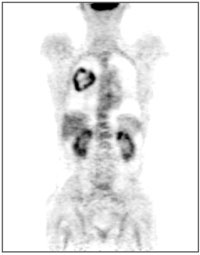A PET Scan (or Positron Emission Tomography) is a non-invasive, diagnostic examination that finds information about the activity of different parts of the body. Those parts of the body that are the most active need energy, and the energy that it uses is sugar (also called glucose). A PET scan uses a specially created substance that the body thinks is sugar, and takes up into the cells. This substance is called a ‘tracer’, and it is almost exactly like sugar, but has a small radioactive part attached to it. The images are based on the detection of radiation from the emission of positrons (positively charged electrons) from this radioactive tracer. The subsequent images created are used to evaluate a variety of diseases, with the most common use being whole body imaging of cancer.
How Does a PET Scan Work?

During a PET Scan
PET scans are generally done in an outpatient setting and preparation is usually set by your doctor. The scan does require the patient to lie still for a period of time up to two hours, so if you feel you may have a problem with this, please talk to your doctor. Women who suspect they may be pregnant or are pregnant need to notify their doctor as this is a radioactive procedure and could have effects on an unborn foetus. The PET scanner is a donut-ring shaped apparatus with an attached table that moves into the scanning ring. Initial scans may be done before you are taken into a special injection room where the tracer is administered, usually intravenously. It will then take 30-90 minutes for the substance to travel through your body and accumulate. During this time you may be asked to rest quietly to allow the substance to travel through the body. You will then be asked to lie still on the scanner table and it will move in through the scanner ring. During the scan, which can take from thirty minutes to two hours, you must lay very still to allow for clarity of the images. After the scan there are no restrictions to daily activity, but it is recommended you drink plenty of water to flush your system of the tracer.
Benefits of a PET Scan
PET scans are beneficial as they demonstrate the biochemical changes in the body, whereas a CT or MRI scan identifies anatomical changes. A PET Scan therefore helps to identify problems at the level of their activity and function, which might change long before any changes in body structure (such as a tumour) become apparent. This allows for earlier diagnosis and more effective treatment of diseases such as cancer, and also more detailed imaging of other conditions. There is little risk involved with the intravenous administration of the radioactive “tracer” as the tracer has a short decay time of only a few hours and is quickly removed from the body.
Risks of a PET Scan
The risks associated with a PET scan are very small, and are due to reactions to the radioactive “tracer” injected. The level of tracer given to a patient is very tiny, and the chances of a reaction occurring are incredibly low.
Limitations of a PET Scan
- PET scans can sometimes show up areas of high activity which may be mistaken for cancers. Inflammatory conditions like rheumatoid arthritis or tuberculosis absorb a lot of the tracer, and so can cause confusing results.
- A PET scan is less accurate in certain situations:
- Slow-growing, less active tumors may not absorb much tracer.
- Small tumors (less than 7mm) may not be detectable.
- High levels of blood sugar can cause the cells to absorb this normal sugar rather than the radioactive, injected kind. Patients are usually fasted for 4 hours before a PET scan, and blood sugar levels measured to lower the chances of this happening.
- The radioactive substance has a very short decay and therefore appointments must run on schedule.
- PET scans are a very expensive form of imaging, and are not readily available. They often accompany other scans such as CT and MRI in order to be diagnostically effective.
Results of a PET Scan

References
- Positron Emission Tomography: Assessment Report. Medicare Services Advisory Committee, 2000. Commonwealth of Australia.
- Soben P, Udelson KE. ‘Thoracic Assessment of myocardial viability by nuclear imaging in coronary heart disease’ [online], UpToDate, 2006. Available at URL: http://www.uptodate.com (last accessed 13/07/06)
- Stark P. ‘Thoracic positron emission tomography’ [online], UpToDate, 2006. Available at URL: http://www.uptodate.com (last accessed 13/07/06)
All content and media on the HealthEngine Blog is created and published online for informational purposes only. It is not intended to be a substitute for professional medical advice and should not be relied on as health or personal advice. Always seek the guidance of your doctor or other qualified health professional with any questions you may have regarding your health or a medical condition. Never disregard the advice of a medical professional, or delay in seeking it because of something you have read on this Website. If you think you may have a medical emergency, call your doctor, go to the nearest hospital emergency department, or call the emergency services immediately.







